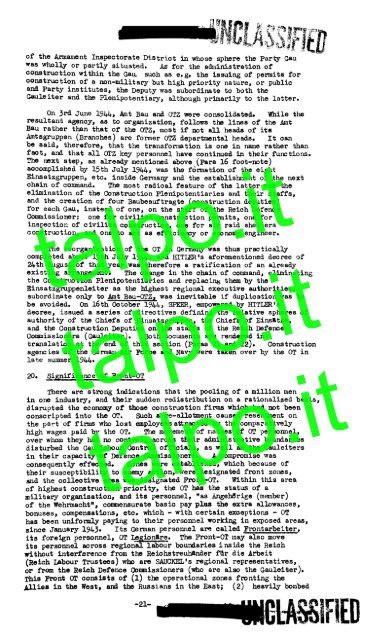ml miRS-tonpon HI 'nrflJIBRCH 1945 Illi - 1GM
ml miRS-tonpon HI 'nrflJIBRCH 1945 Illi - 1GM
ml miRS-tonpon HI 'nrflJIBRCH 1945 Illi - 1GM
Create successful ePaper yourself
Turn your PDF publications into a flip-book with our unique Google optimized e-Paper software.
of the Armament Inspectorate District in whose sphere the Party Gau<br />
was wholly or partly situated. As for the administration of<br />
construction within the Gau. such as e.g. the issuing of permits for<br />
construction of a non-military "but high priority nature, or public<br />
and Party institutes, the Deputy was subordinate to both the<br />
Gauleiter and the Plenipotentiary, although primarily to the latter.<br />
On 3rd June 1944, Amt Bau and OTZ were consolidated. While the<br />
resultant agency, as to organization, follows ths lines of the Amt<br />
Bau rather than that of the OTZ, most if not all heads of its<br />
Amtsgruppen (Branches) are former OTZ departmental heads. I t can<br />
be said, therefore, that the transformation is one in name rather than<br />
fact, and that all OTZ key personnel have continued in their functions.<br />
The next step, as already mentioned above (Para 16 foot-note)<br />
accomplished by 15th July 1944, was the formation of the eight<br />
Einsatzgruppen, etc. inside Germany and the establishment of the next<br />
chain of command. The most radical feature of the latter was the<br />
elimination of the Construction Plenipotentiaries and their staffs,<br />
and the creation of four Baubeauftragte (construction deputies)<br />
for each Gau, instead of one, on the staff of the Reich Defenc3<br />
Commissioner 1 one for civilian construction permits, one for<br />
inspection of civilian construction, one fcr air raid shelters<br />
construction, and one to act as efficiency or economy engineer.<br />
talpo.it<br />
The reorganization of the OT in Germany was thus practically<br />
completed about 15th July 1944* and <strong>HI</strong>TLER'S aforementioned decree of<br />
24th August of that year was therefore a ratification of an already<br />
existing arrangement. The change in the chain of command, eliminating<br />
the Construction Plenipotentiaries and replacing them by the<br />
Einsatzgruppenleiter as the highest regional executive authorities,<br />
subordinate only to Amt Bau-QTZ, was inevitable if duplication was to<br />
be avoided. On l6th October 1944, SFEER, empowered by <strong>HI</strong>TLER'S<br />
decree, issued a series of directives defining the relative spheres of<br />
authority of the Chiefs of Einsatzgruppen, the Chiefs of Einsatze,<br />
and the Construction Deputies on the staffs of the Reich Defence<br />
Commissioners (Gauleiter). Both documents are rendered in<br />
translation at the end of this section (Paras 21 and 22). Construction<br />
agencies of the German Air Force and Navy were taken over by the OT in<br />
late summer 1944*<br />
talpo.it<br />
20. Significance of FrOnt-OT<br />
There are strong indications that the pooling of a million men<br />
in one industry, and their sudden redistribution on a rationalized basis,<br />
disrupted the economy of those construction firms which had not been<br />
conscripted into the OT. Such a re-allotment caused resentment on<br />
the part of firms who lost employees attracted by the comparatively<br />
high wages paid by the OT. The movement of masses of OT personnel,<br />
over whom they had no control, across their administrative boundaries<br />
disturbed the Gau Labour Control officials, as well as the Gauleiters<br />
in their capacity of Defence Commissioners. A compromise was<br />
consequently effected. Zones were established, which because of<br />
their susceptibility to enemy action, were designated front zones,<br />
and the collective area was designated Front-OT. Within this area<br />
of highest construction priority, the OT has the status of a<br />
military organisation, and its personnel, M as Angehflrige (member)<br />
of the Wehrmacht", commensurate basic pay plas the extra allowances,<br />
bonuses, compensations, etc. which - with certain exceptions - OT<br />
has been unifor<strong>ml</strong>y paying to their personnel working in exposed areas,<br />
since January 1943* Its German personnel are called Frontarbeiter,<br />
its foreign personnel, OT Le^ionare. The Front-OT may also move<br />
its personnel across regional labour boundaries inside the Reich<br />
without interference from the Reichstreuhttnder fllr die Arbeit<br />
(Reich Labour Trustees) who are SAUCKEL's regional representatives,<br />
or from the Reich Defence Commissioners (who are also the Gauleiter).<br />
This Front OT consists of (l) the operational zones fronting the<br />
Allies in the West, and the Russians in the East; (2) heavily bombed<br />
talpo.it<br />
-21


